
The planting under the Acacia baileyana ‘Purpurea’ is all fairly new, except for the Plectranthus neochilus. Stinky or not, it’s a great addition to a dry garden. Gomphrena ‘Balboa’ is the clover-like flowers with silver leaves, which blends in seamlessly with all the ballota here. Tall grass in bloom is Stipa ichu, the Peruvian Feather Grass, said to be noninvasive, unlike the fearsome Mexican Feather Grass. California chain Armstrong Nurseries as well as Home Depot have both vowed to no longer sell the MFG, Stipa tenuissima.
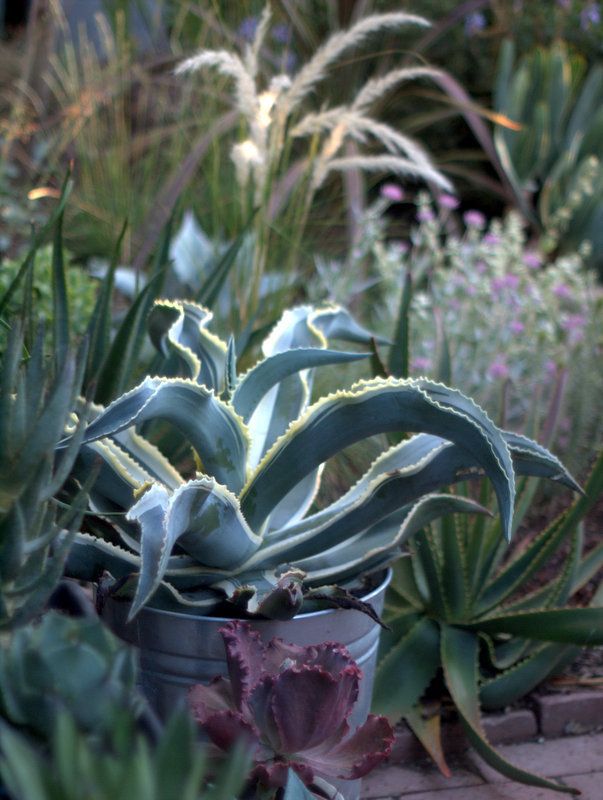
There’s more aloes planted under the acacia than agaves. Currently there’s an Agave ovatifolia in the ground here and a small ‘Dragon Toes.’ Agave gypsophila ‘Ivory Curls’ is still in a container that gets moved around frequently, just because this agave looks great anywhere and everywhere.
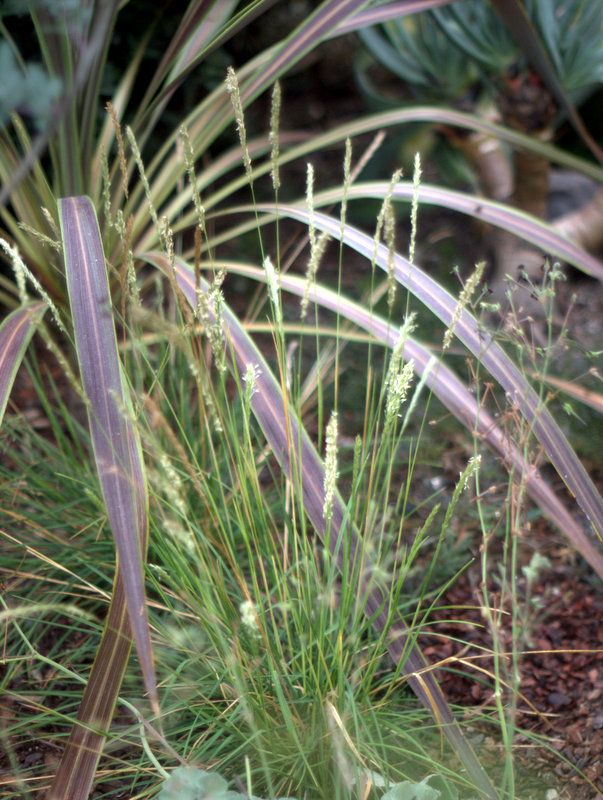
Sesleria autumnalis ‘Campo Verde’ under the arms of Cordyline ‘Electric Star’ Sesleria ‘Greenlee’ is in bloom now too, a little bit shorter in height than ‘Campo Verde.’ Both are wonderful smallish grasses with nice lines and oatsy texture.
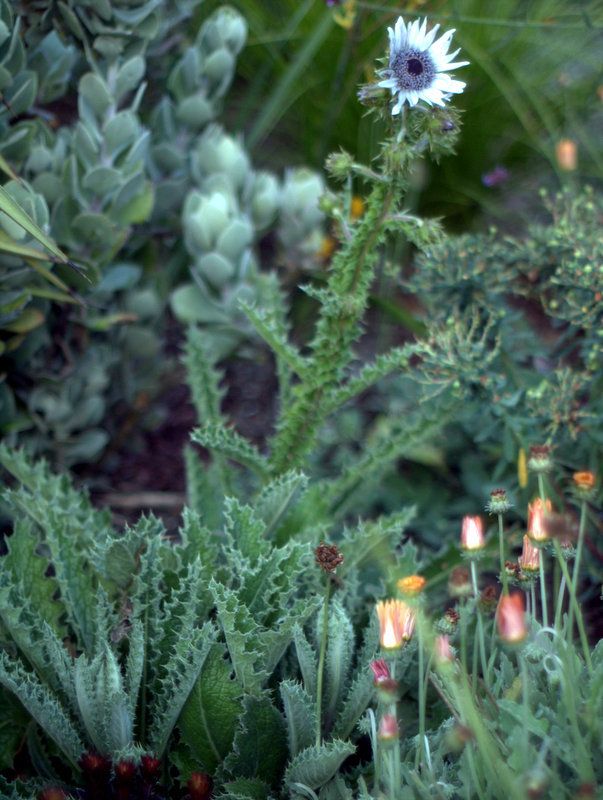
More to the middle of the back garden, Berkheya purpurea just threw out another bloom truss.

The leaves and stems are possibly even more appealing.
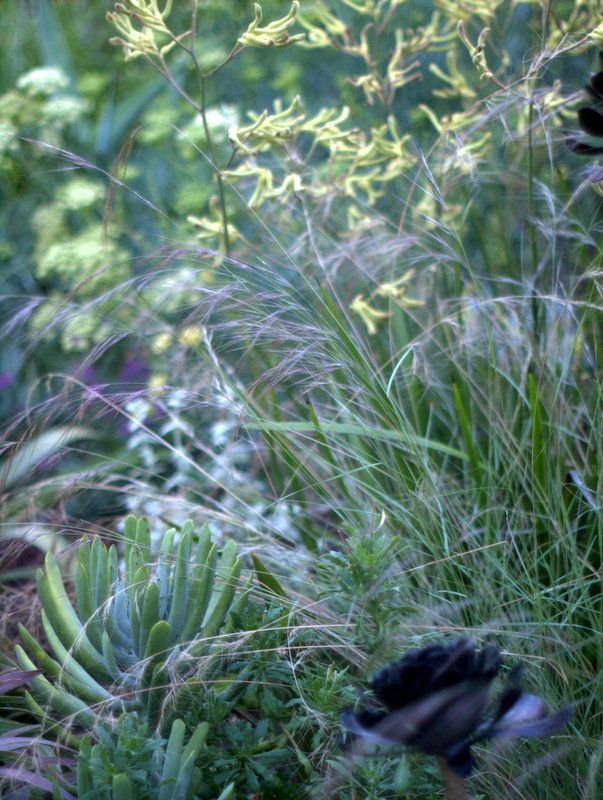
Aristida purpurea will most likely not take over the mantle of the exiled Mexican Feather Grass. Incredibly wispy, falling in all directions.
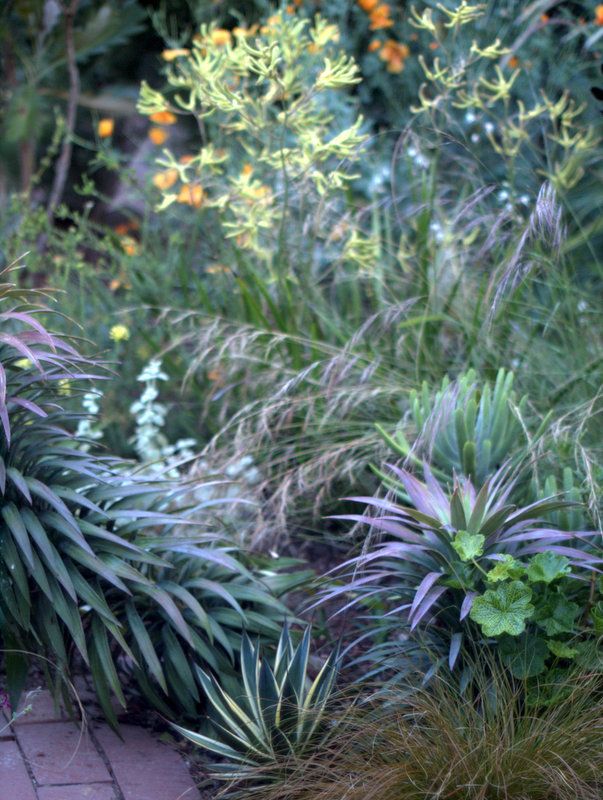
If you didn’t look closely, you’d miss this grass entirely. But at least the others plants are safe from wanton invasion. I haven’t found any seedlings yet. Agave ‘Snow Glow’ is really building size this summer. I’m already thinking of moving it, since Yucca ‘Blue Boy’ is bulking up too. The little South African shrub with tiny, myrtle-like leaves and yellow pinwheel flowers, Gnidia polystacha, is here with anigozanthos, sideritis, and Glaucium grandiflorum
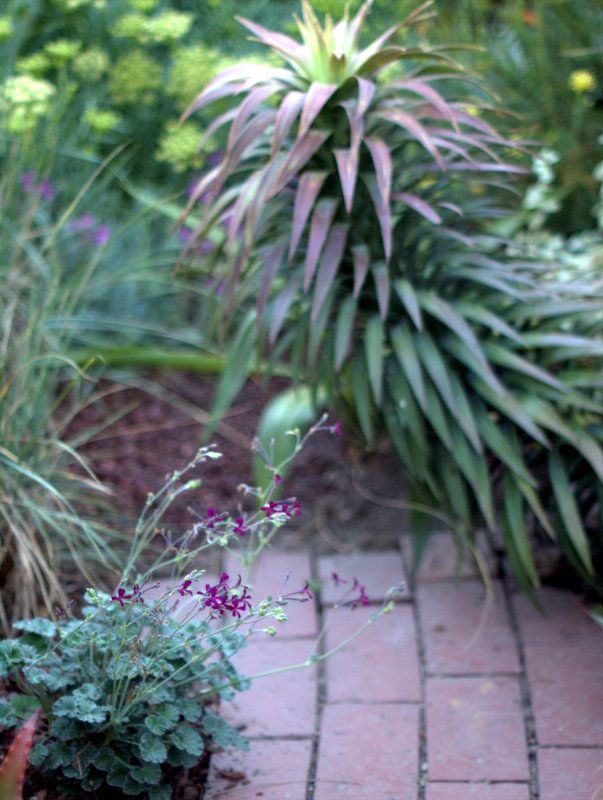
Opposite the yucca I just added Pelargonium sidoides. I’m just now becoming aware of how variable this pelargonium can be. I have a big-leaved, almost black-flowered strain, and maybe I’m imagining it, but this one I just picked up seems to be much brighter in color than the typical velvety maroon. All you lawn replacers, consider this low-growing pelargonium with sesleria, small agaves and succulents, santolina. You can scale up to a smaller conebush like Leucadendron linifolium or choose among the prostrate forms of ceanaothus, grevilleas, and manzanitas. The amount of choices can seem bewildering, but once the wimps are outed and a few things start to thrive, it’s really a matter of building around what remains. If you’re local, email me. I love an excuse to go plant shopping.
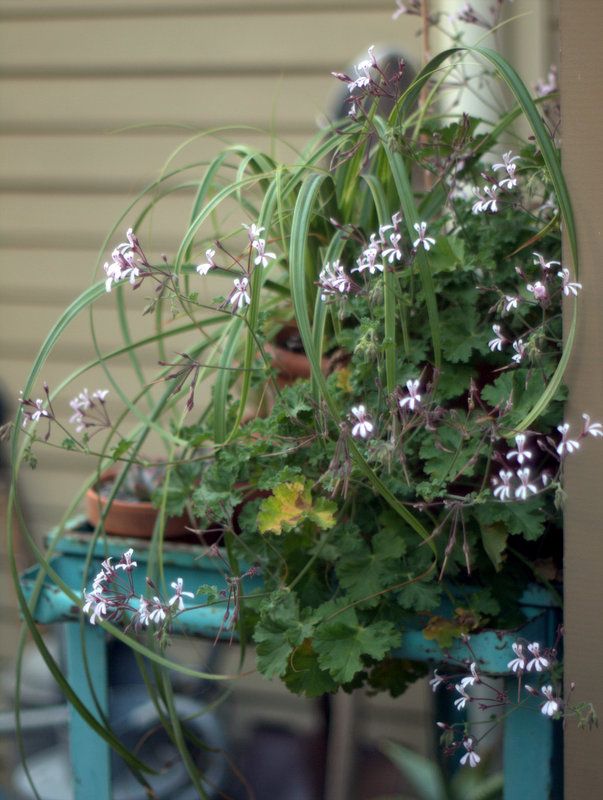
Another pelargonium in bloom, this one in a container. I don’t know the name/didn’t keep the tag. Tiny flowers suspended and hovering like fireworks, good leaves, tolerant of dryish conditions. Running out of containers, I stuck a cutting in this pot with the carex and unseen Aloe harlana that just threw a bloom.
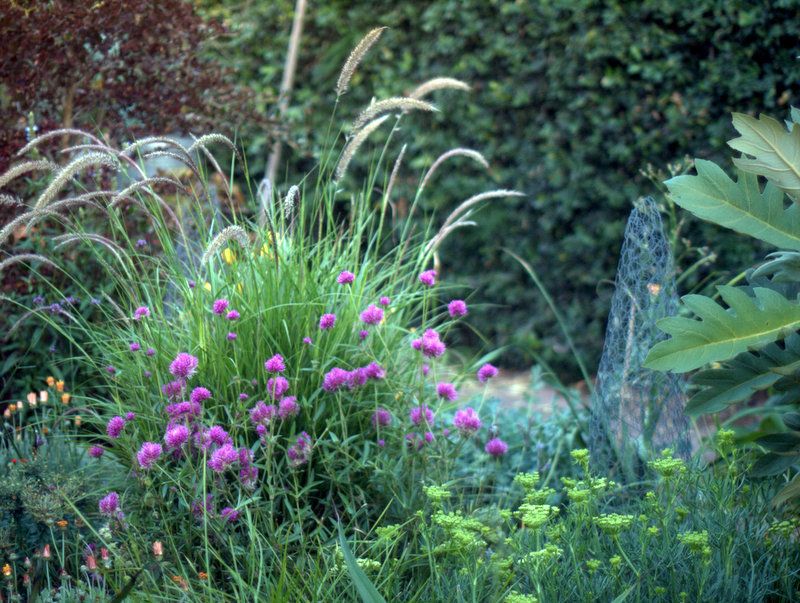
Pennisetum ‘Sky Rocket’ has started to bloom, which just might be my fav for a compact, staying-put kind of grass. Sterile, not hardy. Both the pennisetum and Gomphrena ‘Fireworks’ are perennial here in zone 10. (And, no, your eyes don’t deceive you. That is a chicken-wire cone on the right, made for the holidays a couple years ago.)
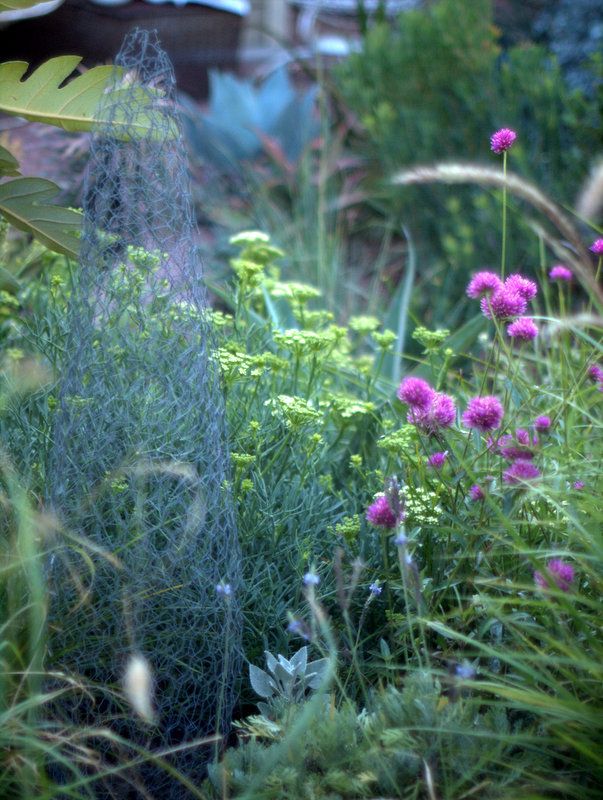
There were two cones made for the mantle. I was playing around with them in the garden yesterday. I think there may be some potential here. Chicken wire orbs, obelisks?
They’re so see-through as to be almost invisible, which may or may not be a good thing, depending on your feelings about stuff made from chicken wire.

In the foreground, that’s Agave vilmoriniana waving its arms frantically, drowning in a sea of Crithmum maritimum. It’ll become huge soon enough, so I don’t want to make it too easy for him. As I’ve said over and over, Crithmum is the best umbellifer for the dry garden, and I’ve tried lots. The Black Parsley, Melanoselinum decipiens, is surprisingly tough but more a specimen plant, with a palm-like habit of growth, and it dies after blooming.
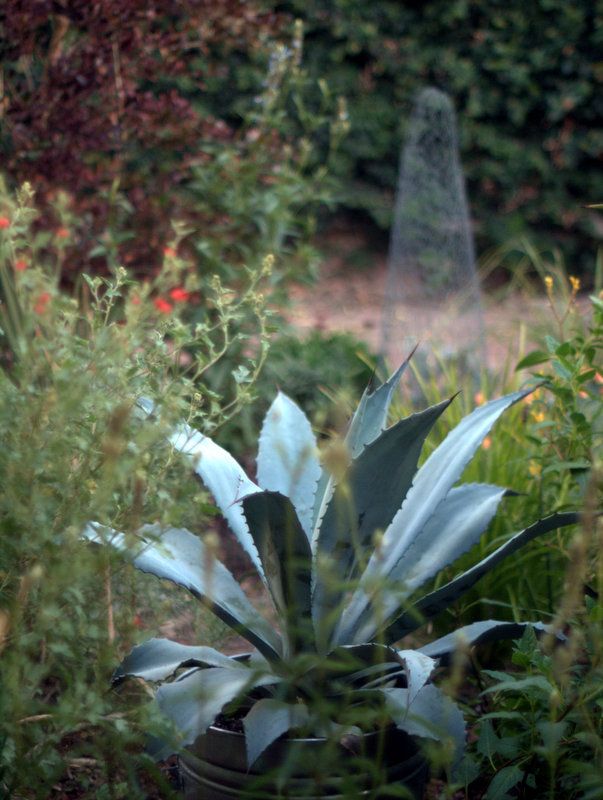
I removed one of the two Sphaeralcea ‘Newleaze Coral,’ the Desert Mallow. They make huge shrubs for summer and one was more than enough. Any plant with the epithet ‘desert’ in its name is worth investigating, and this mallow is amazing. Just be prepared to cut it back several times in summer. (Another ghostly outline of a chicken-wire cone in the background.)
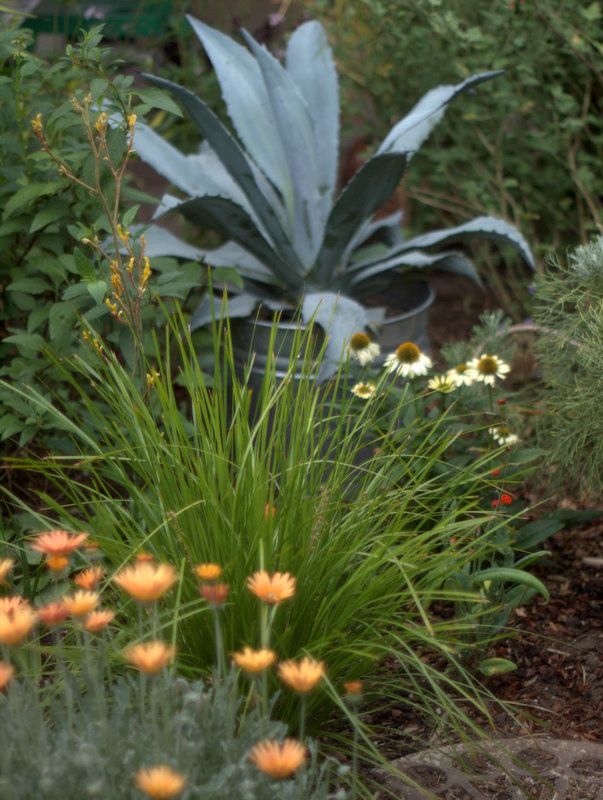
I just pulled out a couple echinacea planted on the other size of the Agave franzosinii that were way too much work to keep hydrated. Aloe ‘Topaz’ got their spot. I guess drought tolerant means different things in different climates. Gaillardia is a much better choice for a summer daisy here. Or arctotis, osteospermum. Grass-like plant is Lomandra ‘Lime Tuff’ which has been flawless so far.
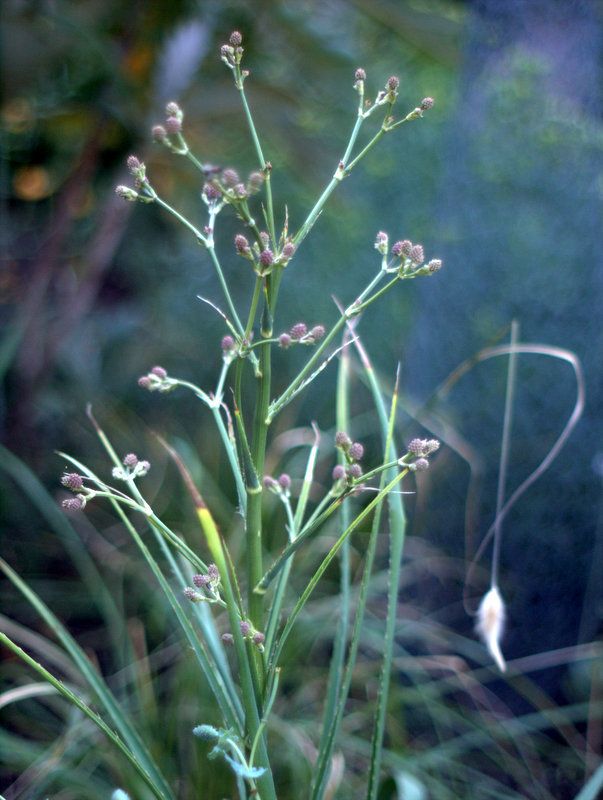
Eryngium pandanifolium, the remaining clump in the garden. I saved a small division of the mother plant, but it’s easier to propagate from seed.
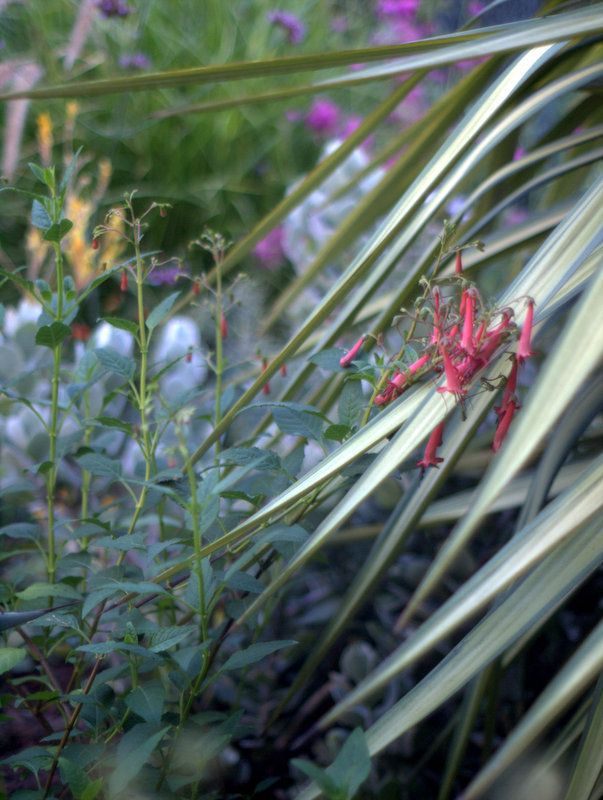
Yucca ‘Margaritaville’ doubling up as a plant support for Phygelius ‘Diablo’
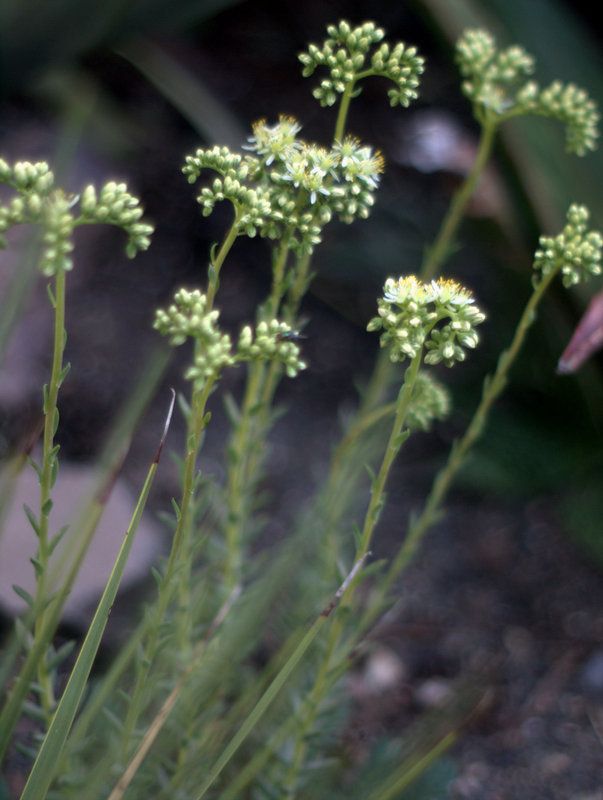
This sedum new to me this year looks really promising. Sedum sediforme ‘Turquoise Tails.’ To Zone 5.
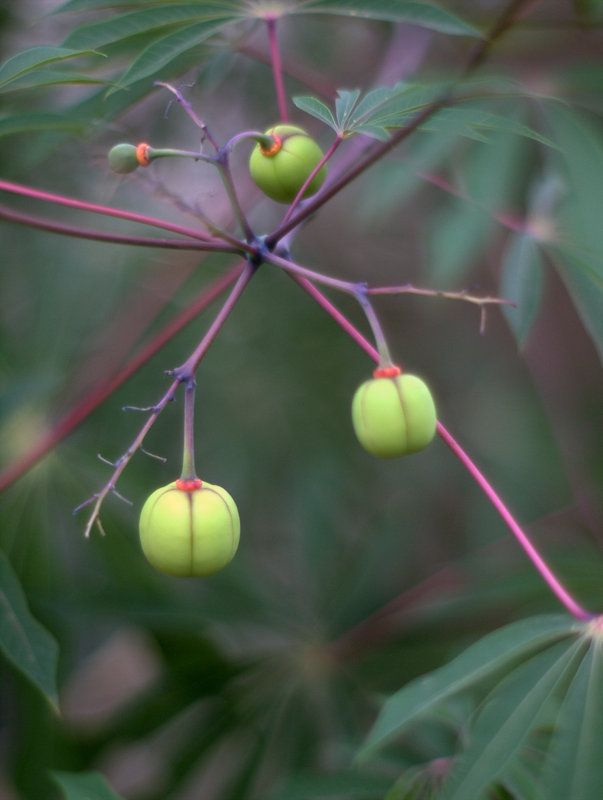
I couldn’t get a good photo of the manihot’s tiny flowers, so beloved by bees, but the pumpkin-like seedpods are cool enough in their own right.
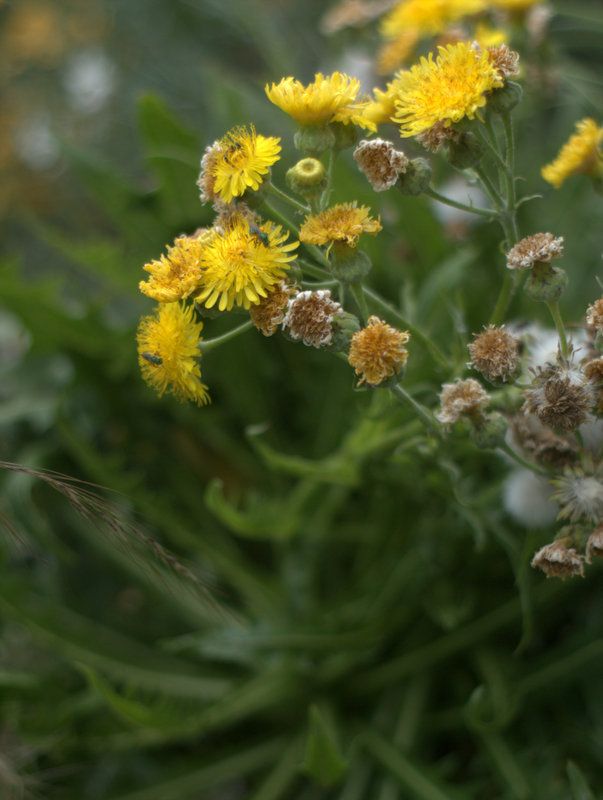
I haven’t let dandelions take over, just a relative, Sonchus congestus.
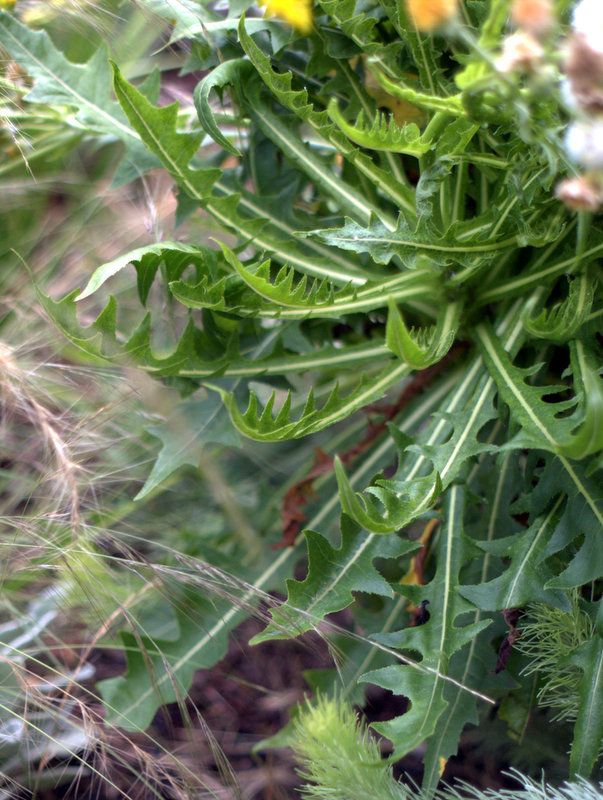
It’s more about the leaves with this plant, but pollinators love the flowers.
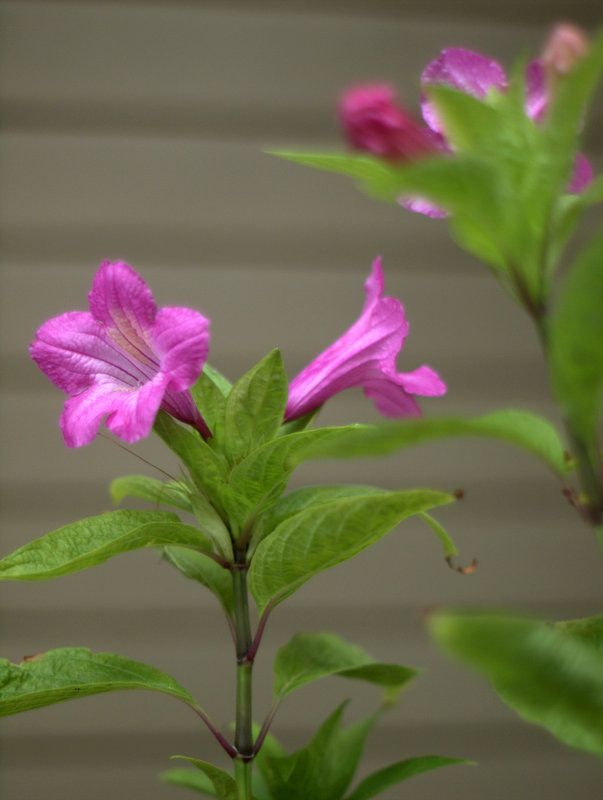
Ruellia macrantha from Brazil wants even moisture, so it stays in a pot. I still can’t believe I couldn’t get the more common Ruellia simplex, or Mexican Petunia, settled into the garden. It has slimmer leaves, dark stems, purple flowers. I see it growing in paving cracks topping 4 feet high and as much across, getting no summer irrigation.
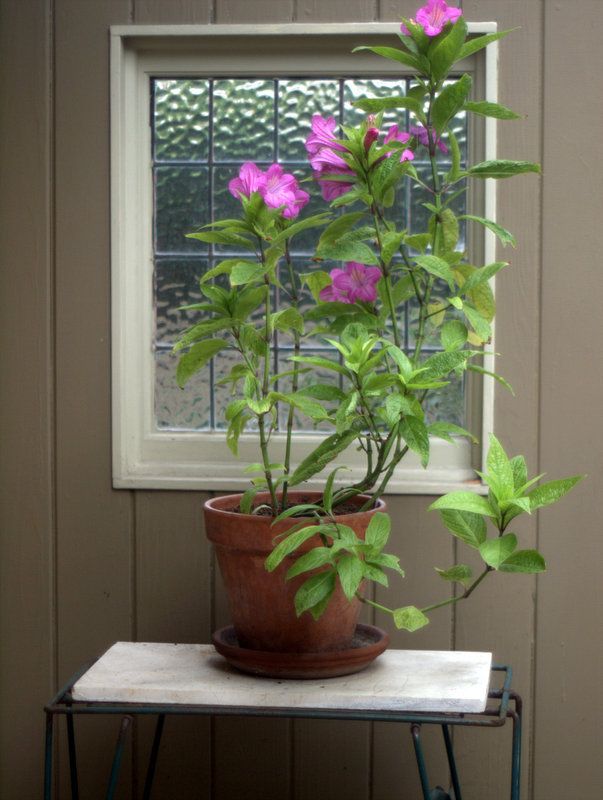
This pink ruellia just started opening blooms a few days ago. Supposedly it will now bloom through winter, so we’ll see how it does.
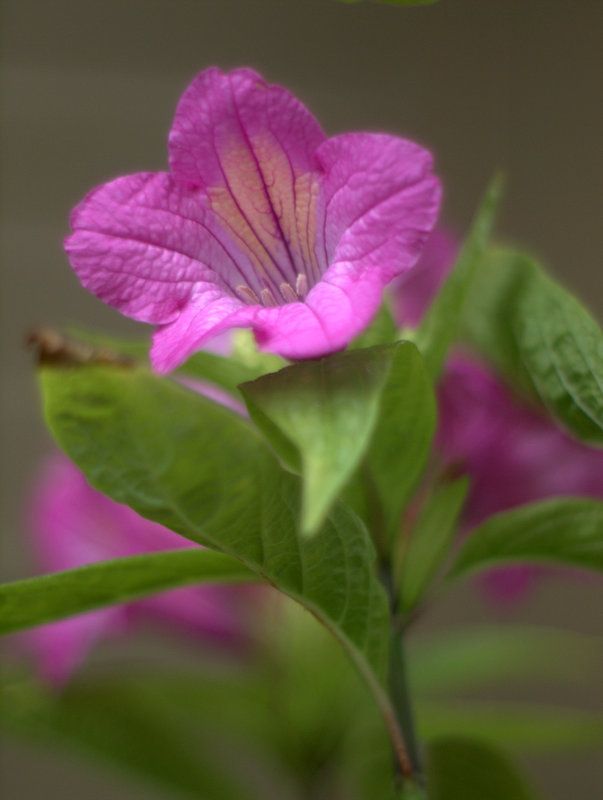
Shrubby and almost azalea-like.
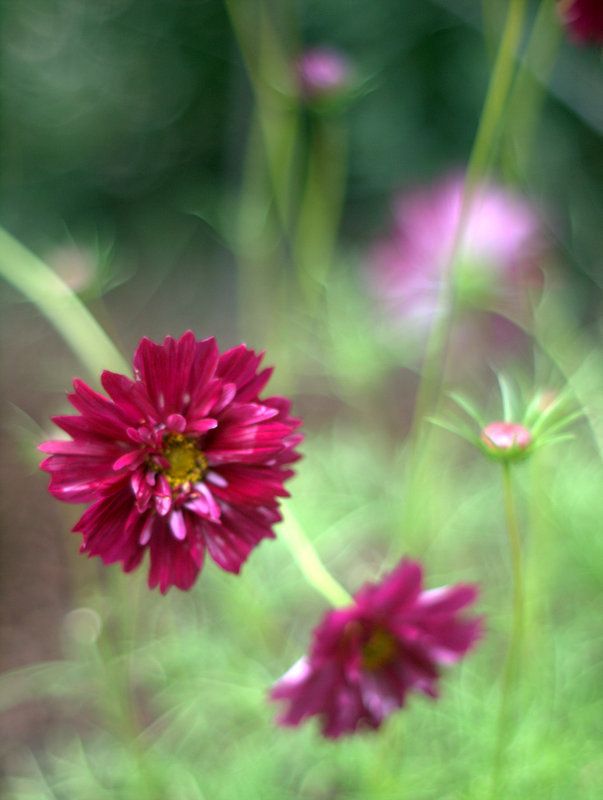
Straight outta the local nursery last week, Cosmos ‘Double Click Cranberry.’ I’d like to collect its seed for the cutting garden I’m envisioning for next summer at the community plot. I’ll leave room for tomato plants and green beans of course.
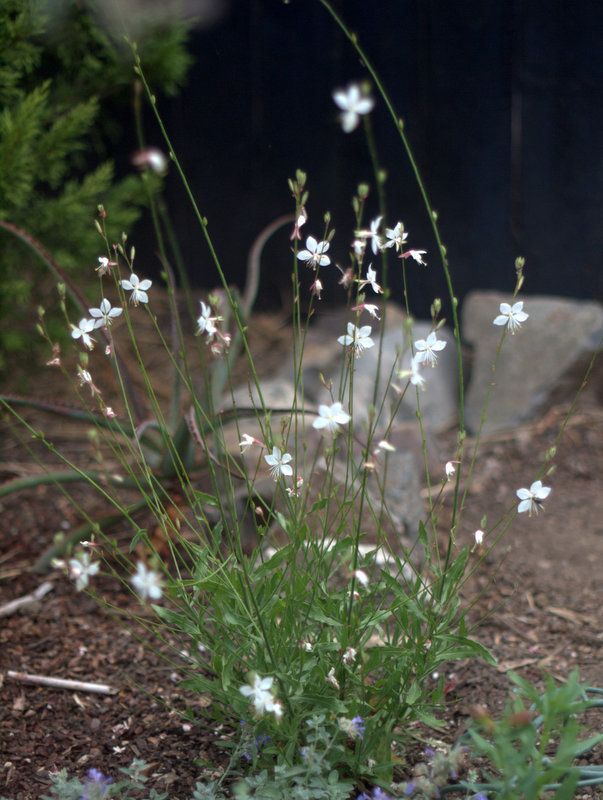
And Gaura ‘Belleza’ is another recent purchase too. This gaura took Ruellia simplex’s vacated spot.
And a couple more gaura replaced Stachys ‘Bella Grigio’ near Sonchus congestus. I potted the stachys up again to see if they could be revived.
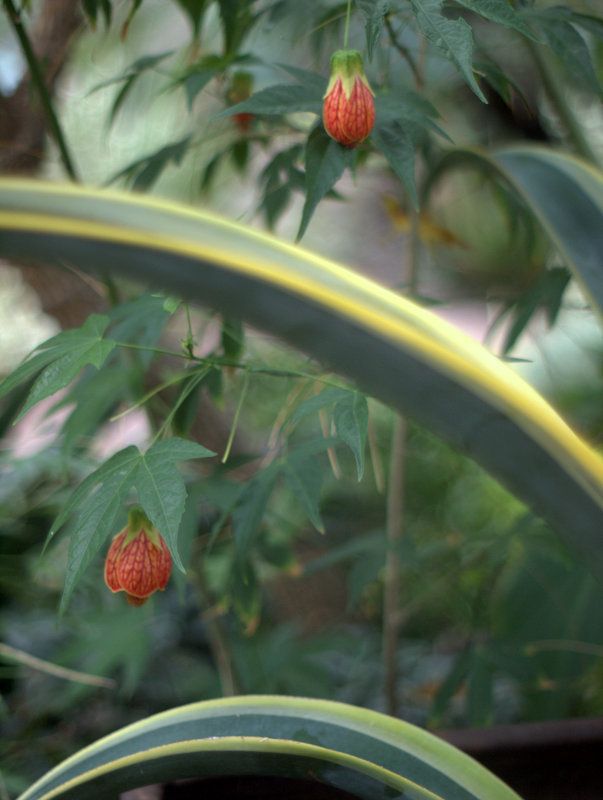
Abutilon venosum
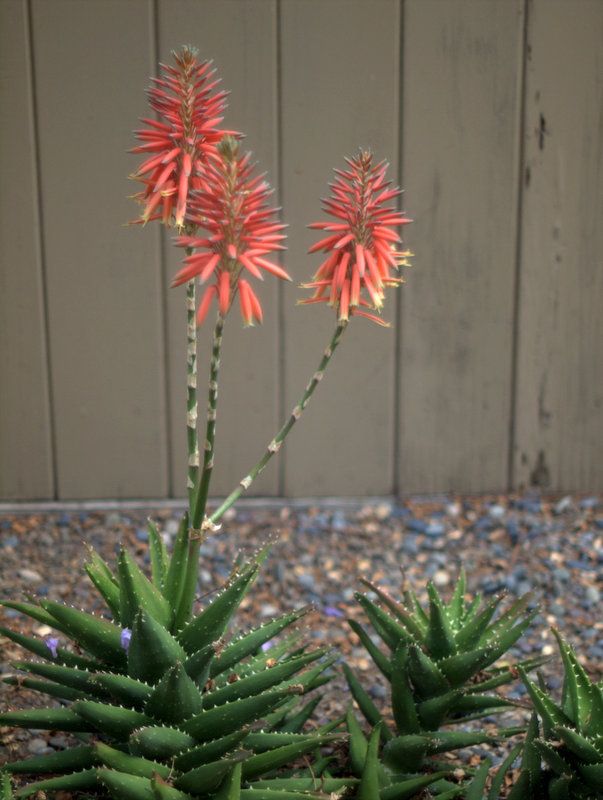
In bloom in the front garden, Aloe distans. July is a month not to be missed for Bloom Day news at May Dreams Gardens.

That Berkheya purpurea is certainly interesting. Very interesting. I can’t believe that Ruellia does well in drought, but maybe being in the ground helps? The potted ones need that moisture or they droop. I have one in the ground now but have a couple more I can plant too as a test (they’re annuals or tender perennials here — spend winter in the garage). Love the Eryngium pandanifolium too — wonder if it’s more cold-hardy than reported as I’d love to try it on my south wall…
I spent a good few hours today, taking a good look at my garden to see what hasn’t been fried by our unusual long, hot, dry summer. I forgot about Sesleria, I have it in a bed that hasn’t gotten a lot of water, and it still looks good. My Echinacea has been fine, but my Rudbeckias are pretty well toasted, and they haven’t even started blooming yet. I love that first shot, such a nice variety.
Beautiful!
I’m glad you included leaf photos – very interesting!
Happy Garden Bloggers’ Bloom Day!
@Alan, I’ll have to get a photo of the ruellia near a local strip mall. It’s been there a few years and is an amazing specimen. I can send some eryngo seeds after it flowers if you’re interested in trying it out.
@Alison, your summer was literally a trial by fire this year!
@Lea, I did kind of blur the lines there a bit. Happy Bloom Day to you as well!
As usual, your post has me taking notes of plant prospects. I’m looking to change out at least some of my Mexican feather grass so Stipa ichu is a good lead – where’d you find it? I’m trying to avoid planting anything until summer is mostly behind us and my remaining lawn comes out but it’s time to start planning.
Kris, the Stipa ichu came from Roger’s. I was told that it was “sterile,” which it isn’t, but it may be shy to set seed. A friend told me he’s seen it over 4 feet high, so there’s a lot of questions to be answered on this grass still.
Is it wrong that in every photo with flowers and an Agave I was more capitivated by the Agave? (One track mind) However those Manihot seed pods are out of this world and your Berkheya purpurea has pushed me over the edge. Must have that one.
I love your garden, Denise. It’s so different from what I can grow and so unique.
What a fabulous post! I would love a tour of your garden, then we can go shopping. Let me know when you have time, please.
@Loree, well, you know where to get a berkheya! I really need to order that Alstroe isabellana this fall.
@Hoov, yes, let’s do that! I’ll email to set up a good time.
Sue, and I love yours that I one day hope to see! You could take in all my back garden on one sip of wine, whereas yours, lordy, we’d need the bottle!
You have so many fab blooms in your garden this month! As usual, many of them are new to me. Always love the soft and romantic way you photograph your outstanding garden! Would love to see your garden and go plant shopping! If we ever get back to your area, I’ll definitely let you know!
I like posts that introduce me to unfamiliar. Lots of unfamiliar in your garden, and some familiar that I did not know names of.
Ray
I’m amazed at how frequently you move/remove/change plants out in your garden. It often takes me over 5 years to make changes, but the plants in pots never planted out, that’s another story altogether, as they usually rotate into a client’s garden at some point. For such a small sized garden, you show no fear with such large growing Agaves.
I wouldn’t have thought Ruellia macrantha a good fit for your gardening style emphasizing the delicate and drought tolerant, but I love it too, especially for the vibrant winter blooms that combine well with my tropical cloud forest plantings. But that Ruellia is a denizen of sparse, rocky chaparral-like Campo Rupestre in Minas Gerais, which otherwise quite resembles our soft coastal chaparral habitat along the coast.
@Ray, I love trying out new plants, nothing tricky, but something unfamiliar that might thrive here.
@David, that ruellia is me looking ahead at something for winter. It does look out of context in bloom right now, doesn’t it? I do change up stuff all the time, and sometimes lose a grouping of plants that makes me wistful, sometimes gain something striking, but I do like change! Thanks for the backstory to this ruellia. The name Minas Gerais sounds like something out of Tolkien! This winter I might turn up the sun exposure on it — leaves were burning in full summer sun.
Ruellia can handle full intense tropical summer sun in Brazil, but remember that their dry season comes in winter, and regular showers and higher humidity occur in their summers. I seldom see this blooming in July here in my gardens, but sometimes an individual plant does, just like the unseasonal sprinkling of summer blooms on my Brazilian Tibouchina organensis.
Maybe the english translation of Minas Gerais is less romantic; General Mines, from the gold, diamonds and precious stones the state was known for in the colonial era. The baroque architecture of many of these colonial towns is gorgeous, Ouro Preto in particular deserves to be seen!